10 Ways to Fix Sony TV’s Wi-Fi Disconnect & Turn Off Woes
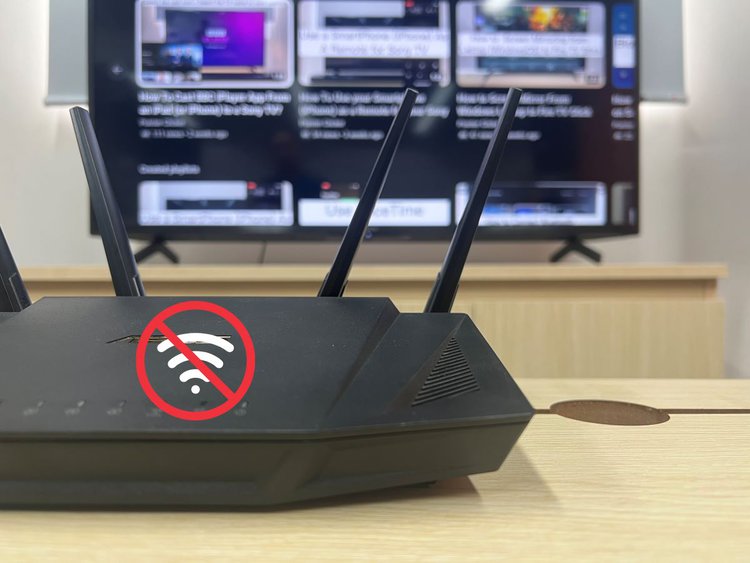
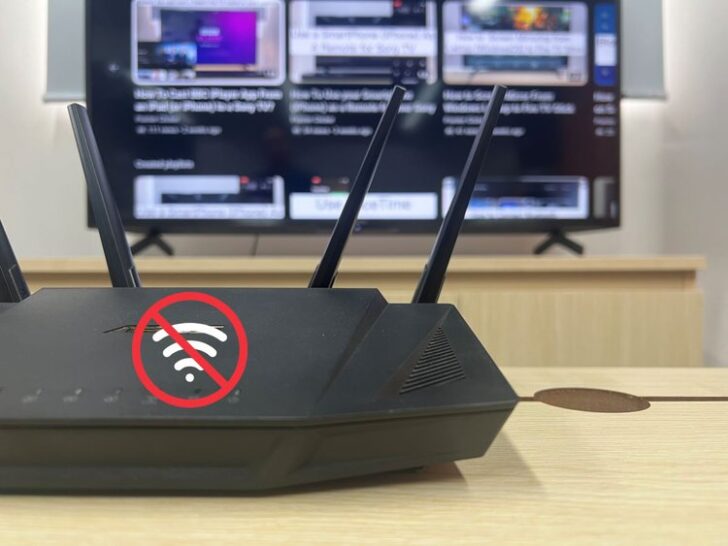
- Wi-Fi disconnections can result from weak signals, routers too close to TVs, or overcrowded networks; verifying Wi-Fi strength and optimizing device placement can help.
- To maintain a stable connection, restart the network by unplugging devices or updating your Sony TV software for any available patches.
- For consistent connectivity, consider switching to a wired Ethernet connection or adjusting the router’s frequency to reduce interference and disconnections.
Are you experiencing interruptions with your Sony TV’s Wi-Fi connection? Rest assured, you’re not alone.
Numerous users have encountered similar connectivity issues where their Sony TV frequently loses its Wi-Fi connection or the Wi-Fi feature even shuts down.
This article, backed by our tech team’s expertise and insights from various forums, will guide you through actionable solutions to these common hitches.
Dive in to get your connection stable and hassle-free.
Quick Navigation
Your Sony TV Randomly Disconnects From Wi-Fi
If your TV’s Wi-Fi connection is randomly and frequently cutting out while you’re watching content, playing games, or browsing the app store, there’s most likely something wrong with your router or Sony TV software.
1. Weak Wi-Fi Signal
Weak Wi-Fi signals can frequently cut out as they struggle to maintain a connection to the device, in this case, a Sony TV. You may also notice that your Wi-Fi connection is slow and that the content you’re watching is lagging.
If you suspect your Wi-Fi signal may be weak, it’s a good idea to verify its strength by following the steps below:
Step 1: Head to the Settings.
Step 2: Go to Network & Internet and check the signal strength by observing how many of the Wi-Fi symbol’s curved lines are darkened. If half or less of the curved lines are darkened, then your Wi-Fi signal may be too weak to support your TV’s connection.
To strengthen your Wi-Fi signal, decrease the distance between your TV and router, ensuring both are placed in the same room. If your home’s layout does not allow you to physically move these devices closer, consider using a budget-friendly Wi-Fi extender. Alternatively, you can use a Wi-Fi mesh system if you’re willing to splurge a little more for a higher-end Wi-Fi setup and need to cover a wider range.
2. The Router Is Too Close to the TV
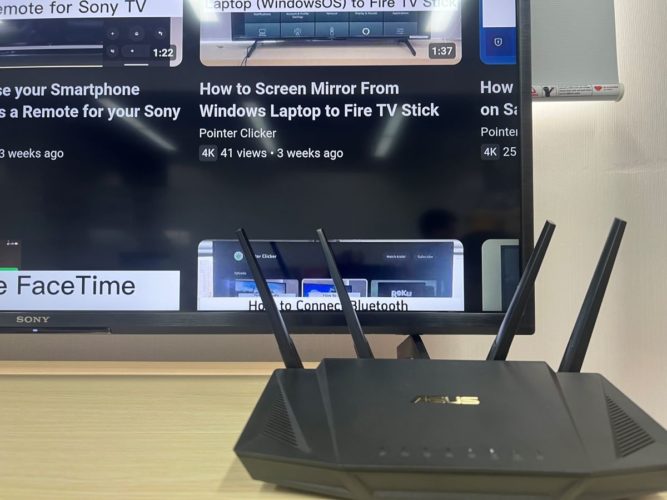
While your router shouldn’t be too far away from your TV that it’s out of range, placing it too close to your TV can also negatively affect signal strength.
Placing your router directly beneath or next to your TV can cause the signal to be blocked by the TV’s metal components and shielding. For the Wi-Fi signal to reach the TV properly, there must be sufficient distance between the two.
So, it’s recommended to have your router be at least three feet away from your TV and other Wi-Fi-capable devices.
3. Too Many Devices Are Connected to Your Wi-Fi
On paper, routers should be able to support up to 250 devices at one time with little effect on the Wi-Fi speed. However, in practice, this number is usually around 50 devices.
Connecting too many devices to your router can cause the speed and bandwidth to dwindle, and for a few devices to get “kicked out” (or cut off) from the network.
So, if you have several smartphones, tablets, TVs, consoles, streaming devices, or any other network-capable devices connected to your Wi-Fi, your router may kick your Sony TV out.
Remember that devices on standby still consume bandwidth and can contribute to your router becoming overwhelmed.
So, it’s a good idea to disconnect any devices you’re not using from your router. Or, check out our article How to Fix Too Many Devices on a Wi-Fi Network for some alternate solutions.
4. Restart the Network
If your other devices are also disconnecting from Wi-Fi, your router may be to blame. Glitches or bugs in the connection can cause the router’s signal to cut. So, to resolve these issues, it’s best to restart it.
Step 1: Power off your TV before unplugging your modem and router’s power cables.
Step 2: Leave all your devices turned off/unplugged for at least 30 seconds.
Step 3: First, plug the modem’s power cable back into a wall outlet and wait a minute or so for it to fully restart.
Step 4: Then, reconnect your router to power and allow it to fully reboot.
Step 5: Power on your TV.
Step 6: If your TV doesn’t connect to Wi-Fi automatically, head to its network settings to connect it manually. Then, observe if it maintains a stable connection with your router.
5. Update Your Sony TV
Follow the steps below to update your Sony TV with Android or Google TV.
For Sony TVs with Android TV
Step 1: Go to the Home screen by pressing Home on your remote.
Step 2: Head to the left of the screen and open Apps.
Step 3: Navigate to Help.
Step 4: Click on Status & Diagnostics.
Step 5: Go to System Software Update.
Step 6: Select Software Update.
Step 7: If there is an available update, follow the on-screen instructions to download and install it.
Watch the video below to learn how to update a Sony TV with Android TV.
For Sony TVs with Google TV
Step 1: Press your remote’s Settings button.
Step 2: Navigate to System.
Step 3: Go to About.
Step 4: Head to System Update.
Step 5: Select Check for Update.
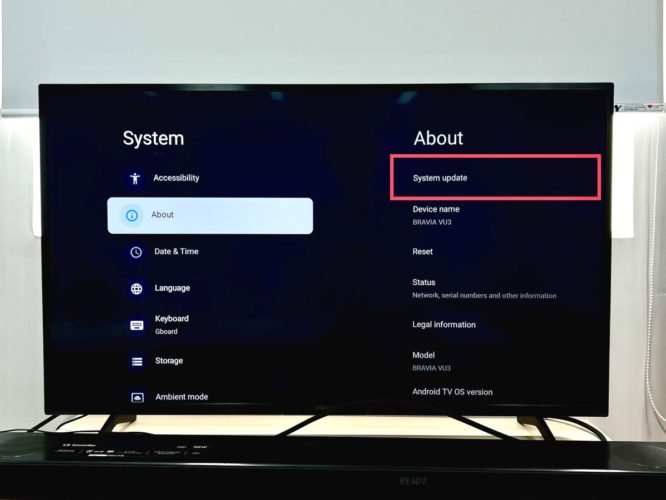
6. Switch to 5GHz Wi-Fi
There are two main frequency bands that routers can use: 2.4GHz and 5GHz.
While most devices use the 2.4GHz frequency band to gain connection to the internet, it can become overcrowded, leading to interference and, at times, devices randomly disconnecting.
So, it’s a good idea to verify if your router supports the 5GHz frequency band and connect to it if possible.
Step 1: Ensure your computer is connected to your router’s Wi-Fi network.
Step 2: Launch a web browser.
Step 3: Refer to the sticker on the back of your router to find its IP address. Then enter this address into the browser’s URL bar.
Step 4: Take note of the router’s username and password (often found on the back of the router) and enter them into the login page.
Step 5: Once you’ve logged into your router’s web page, go to Advanced Settings, followed by Wireless.
Step 6: Toggle Enable Smart Connect off.
Step 7: Adjust the Band to 5GHz.
Step 8: Enter a Network Name for the 5GHz band.
Step 9: Set Hide SSID to No.
Step 10: Set a password for WPA Pre-Shared Key.
Step 11: Then, set the Band to 2.4GHz.
Step 12: Adjust Hide SSID to Yes.
Step 13: Finally, click Apply to save your changes.
Watch the video below demonstrating how to change your router to the 5GHz frequency band.
7. Switch to an Ethernet Cable (Highly Recommended)
If you’ve tried all of the above solutions, but your Sony TV is still disconnecting from Wi-Fi, it’s a good idea to connect it to a wired Ethernet connection. Many Sony smart TVs have an Ethernet port, making setting up a wired internet extremely fast and easy.
Step 1: Connect one end of a compatible Ethernet cable (there should be one of your router’s packaging) to your Sony TV’s Ethernet port before connecting the other end to your router.
Step 2: Should your Sony TV not feature an Ethernet port, plug a USB to Ethernet Adapter into one of its USB ports before connecting the Ethernet cable to it accordingly.
Step 3: Next, go to your TV’s Settings.
Step 4: Open Network & Internet.
Step 5: Toggle Wi-Fi off.
Your Sony TV Disconnects From Wi-Fi Right Away When It’s Turned On
While your TV is not randomly disconnecting from Wi-Fi while you’re watching content, its Wi-Fi settings do turn off every time your turn on your TV. Alternatively, your TV’s Wi-Fi settings do turn on whenever your turn on your TV, but it does not connect to a network.
Follow the solutions below if your Sony TV’s Wi-Fi problems are similar to either of these scenarios!
1. Connect to 2.4GHz Wi-Fi
Before connecting your TV to 2.4GHz Wi-Fi, you must ensure this frequency band has been enabled on your router. While this process does tend to vary between router brands, the general instructions below should give you a good idea about how to adjust these settings on your models.
Step 1: Connect your computer to your router’s Wi-Fi network.
Step 2: Launch any browser on your computer. (This process can not be done on a mobile device.)
Step 3: Type your router’s IP address (commonly found on a sticker on the back of the router) into the browser’s URL bar before pressing Enter.
Step 4: When prompted, carefully enter the correct username and password (if needed). You should be able to find them on the same sticker you found the IP address.
Step 5: Go to Advanced Settings. Then, open Wireless.
Step 6: Disable Enable Smart Connect.
Step 7: Set the Band to 2.4GHz.
Step 8: Enter a Network Name for the 2.4GHz band.
Step 9: Go to Hide SSID and select No.
Step 10: Then, set a password for the WPA Pre-Shared Key.
Step 11: Adjust the Band to 5GHz.
Step 12: Under Hide SSID, click Yes.
Step 13: Click on Apply.
Watch the video below demonstrating how to set your router’s frequency band to 2.4GHz.
Now that you’ve adjusted your router’s frequency band, you can connect your TV to the 2.4GHz Wi-Fi network.
Step 1: Head to the Settings.
Step 2: Navigate to Network & Internet.
Step 3: Click the 2.4GHz Wi-Fi network’s SSID.
Step 4: Enter the SSID’s password, which should not have changed.
2. Enable IP Control
Your TV’s network components may be struggling to restart each time you turn your TV on, resulting in it not connecting to Wi-Fi. So, it’s best to enable IP Control, which will ensure these components remain powered when your TV is turned off but still plugged into power (i.e. in standby mode).
Step 1: Open the Settings.
Step 2: Go to Network & Internet.
Step 3: Navigate to IP Control.
Step 4: Toggle on Control Remotely.
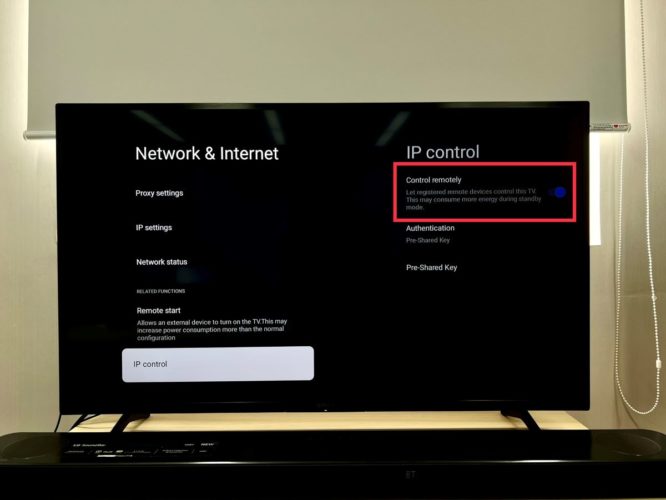
3. Factory Reset Your Sony TV
If you suspect there may be something wrong with your TV’s network settings, it’s a good idea to factory reset your TV to revert all settings to their default values. However, not only will this solution erase all of your TV’s data and settings, but it will also allow said data to be connected by both Sony and Google.
If you err on the side of caution when dealing with your device’s data, I recommend avoiding this solution and trying some of the other methods listed above.
Otherwise, follow the instructions below to factory reset your Sony TV.
Step 1: Navigate to the Settings.
Step 2: Open System.
Step 3: Go to About.
Step 4: Head to Reset.
Step 5: Go to Factory data reset.
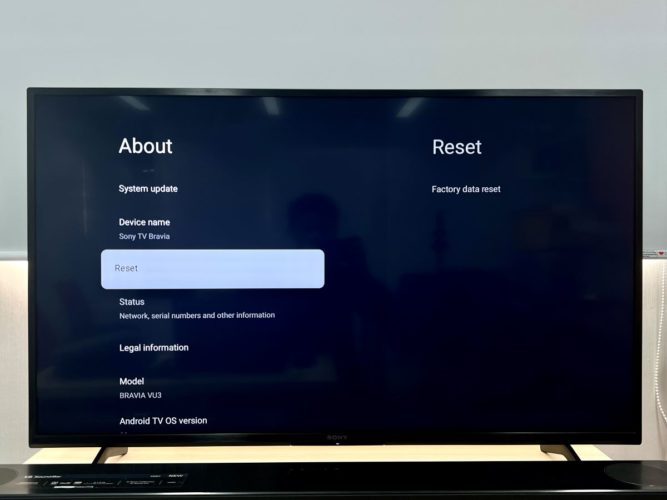
Step 6: Select Factory data reset again to confirm.
Step 7: Wait a few minutes for this process to finish, taking care not to turn off or unplug your TV in the meantime.
Step 8: When your TV has successfully factory reset and restarted, accept all services on the Google Services page.
Step 9: When you arrive at the BRAVIA Privacy Policy, click on Agree to all.
Both Steps 8 and 9 will give Google and Sony access to your data.
Wrapping Things Up
If your Sony TV is disconnecting from Wi-Fi (either randomly or whenever it starts up), then your Wi-Fi signal may be weak, overcrowded, or glitching. Your TV may also be connected to an overwhelmed frequency band.
Alternatively, there may be something wrong with your TV’s network settings, prompting you to factory reset it.
Remember, factory resetting your TV will require you to give Google and Sony access to your TV’s data.
What’s your experience with your Sony TV frequently disconnecting from Wi-Fi? Have any of our solutions helped your Sony TV maintain a stable connection to your router?
Let us know in the comments below!
Yesenia Achlim is a technical copywriter and editor with a focus on AV equipment. She aims to break down complicated topics and make technology accessible, no matter your technical expertise. When she’s not teaching you how to replace a projector lamp, you can find her reading and baking.


